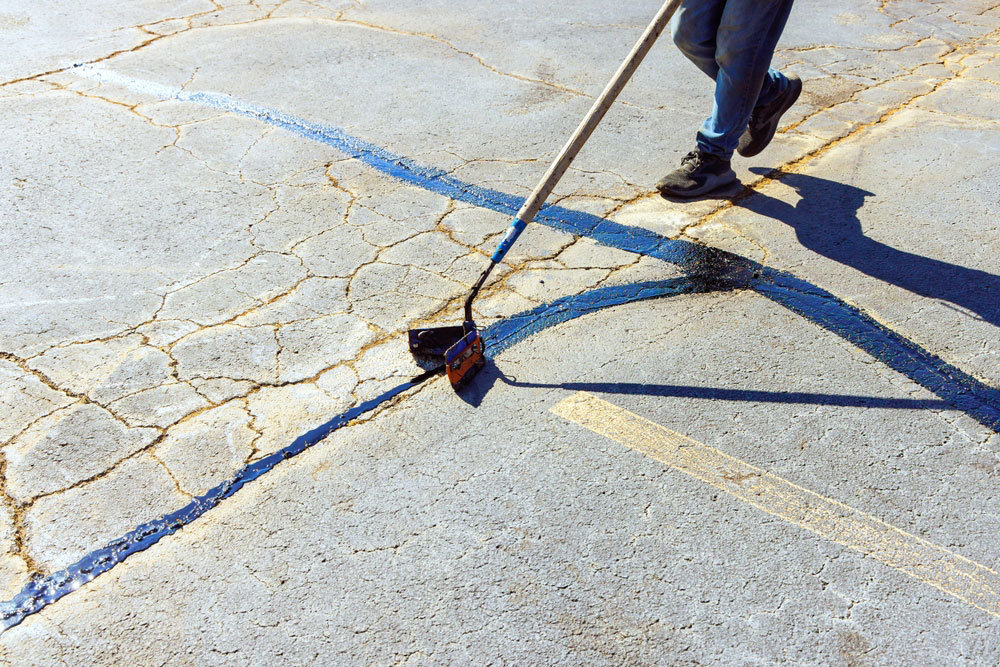As a property owner, it’s crucial to recognize the signs that your asphalt pavement needs repair. You might notice cracks or potholes forming, or perhaps the surface is starting to fade.
These issues can lead to more significant problems if left unaddressed. Understanding what these signs mean and how they can affect your pavement’s longevity is important.
So, what should you be looking for to ensure your pavement stays in good condition?
Cracks and Fissures
Small cracks may seem minor, but they can lead to major problems if left untreated.
Why Cracks Matter
Ignoring cracks can lead to expensive repairs.
- Water can seep beneath the surface, weakening the base
- Expansion and contraction from temperature changes worsens the damage
- Small fissures can quickly grow into potholes or structural issues
Timely Repairs Make a Difference
Quick action helps preserve your pavement.
- Seal cracks early to prevent water infiltration
- Use professional-grade materials for long-lasting protection
- Schedule regular inspections to catch damage before it spreads
Preserve Value and Safety
Maintaining your asphalt enhances both durability and safety.
- Reduces long-term maintenance costs
- Improves appearance and curb appeal
- Creates a safer surface for vehicles and pedestrians
Addressing cracks and fissures early is a simple yet effective way to protect your asphalt investment.
Potholes and Depressions
Potholes and depressions in your asphalt are not just eyesores; they can pose significant safety hazards. Whether in a driveway, parking lot, or road, these issues can lead to vehicle damage, pedestrian accidents, and expensive repairs.
It’s important to address them promptly to ensure your pavement remains safe and durable.
Why Potholes and Depressions Form
Understanding the causes of these issues can help prevent them from worsening.
- Water damage: Water seeping into cracks weakens the asphalt, causing it to sink or crack further.
- Heavy traffic: Constant pressure from vehicles, especially heavy ones, can cause asphalt to deform.
- Temperature fluctuations: Freeze and thaw cycles can lead to cracking and sinking, especially in colder climates.
- Poor installation: If the base beneath the asphalt is improperly prepared, it can cause the surface to sink.
The Risks of Ignoring Potholes and Depressions
Failing to address these issues quickly can lead to more serious and costly consequences.
- Vehicle damage: Potholes can cause tire blowouts, alignment issues, and suspension problems.
- Safety hazards: Depressions can trip pedestrians, increasing the risk of falls and injuries.
- Further deterioration: Left untreated, potholes grow bigger and deeper, affecting the entire surface.
How to Handle Potholes and Depressions
Early intervention can save you from bigger, costlier repairs.
- Regular inspections: Routine checks help identify issues before they become major problems.
- Timely repairs: Fill potholes and seal depressions as soon as you spot them.
- Professional help: Contact a paving expert to assess the damage and carry out proper repairs to restore your pavement’s integrity.
By addressing potholes and depressions early, you’ll not only improve the appearance of your asphalt but also ensure safety and extend its lifespan.
Fading and Discoloration
Fading and discoloration are common indicators that your asphalt pavement is starting to lose its protective layer. Over time, exposure to the sun’s UV rays, heavy traffic, and harsh weather conditions can cause the surface to fade, making it less effective in safeguarding the underlying layers.
If left untreated, this deterioration can lead to further damage and reduced lifespan.
Causes of Fading and Discoloration
Several factors contribute to the fading and discoloration of your asphalt:
- UV exposure: Continuous exposure to the sun’s UV rays breaks down the protective coating, leading to fading.
- Weather conditions: Rain, snow, and freezing temperatures can also accelerate the deterioration of the surface.
- Chemical spills: Oil, gas, and other chemicals can discolor the asphalt and compromise its structure.
The Impact of Fading on Your Asphalt
While fading is primarily an aesthetic concern, it can also signal deeper issues:
- Weakened surface: As the color fades, the protective layer is diminished, making your asphalt more vulnerable to cracks and water infiltration.
- Increased maintenance costs: Without proper sealing and restoration, faded asphalt can lead to more frequent repairs and higher costs.
- Reduced curb appeal: Discoloration can make your property look neglected, affecting the overall aesthetic and value.
How to Prevent Further Discoloration
Proper care and maintenance can help prevent further damage:
- Sealcoating: Apply a protective sealcoat to restore the surface’s color and protect it from the elements.
- Regular cleaning: Keep your asphalt clean by removing oil spills and debris that could contribute to discoloration.
- Routine inspections: Check your asphalt periodically to detect early signs of fading and take corrective action before it worsens.
By addressing fading and discoloration early, you can maintain the integrity and appearance of your asphalt, ensuring it lasts longer and performs effectively.
Addressing these common asphalt issues early on can help you avoid costly repairs and extend the lifespan of your pavement. Whether it’s cracks, potholes, or fading, taking prompt action ensures a safer, more durable surface while preserving the aesthetic and structural integrity of your property.
Regular inspections and timely repairs are key to maintaining a smooth and resilient asphalt surface for years to come.

